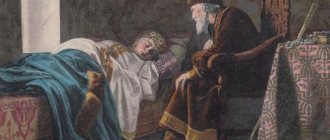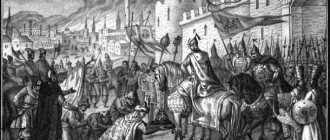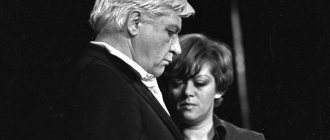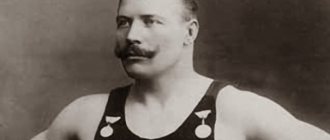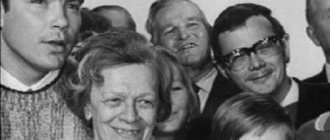The wives of Ivan the Terrible are both a scandalous and not fully clarified issue. Their number is considered controversial. A serious political struggle was waged against the tsar; opponents denigrated the personal life of the monarch, claiming that he lived unmarried and killed spouses who did not like him.
Two women from the above list are considered by historians to be fictional characters. The king married only four spouses. So how many wives did Ivan the Terrible have? Let's explore this complex issue.
Anastasia Romanovna Zakharyina-Yuryeva
Immediately after the crowning of the kingdom, 16-year-old Ivan (he would acquire the nickname the Terrible Tsar later) decided to get married. The procedure for choosing brides was not new: letters were sent to the boyars in all the lands of the Moscow kingdom so that they would present their daughters - girls of the appropriate age - to the governors for review. After the initial “casting,” the girls were sent to Moscow. And Ivan IV himself chose the best of the best.
Note: The Tsar tried to infuse new blood into his family, but it didn’t quite work out: the young monarch’s first wife was his sixth cousin.
On February 3, 1547, a magnificent wedding took place. Ivan IV lived with Anastasia Zakharyina-Yuryeva for a happy 13 years. There was complete understanding between the spouses. The balanced Anastasia restrained the tsar’s quarrelsome and emotional character. The woman did not directly interfere in politics, but the actions of her husband in the period 1547-1560. They were distinguished by common sense and gentleness.
Anastasia gave birth to numerous children:
- Anna (1549-1550);
- Maria (1551-1552);
- Dmitry (1552-1553, died due to an accident);
- Ivan (1554-1581), who died childless;
- Evdokia (1556-1558);
- Feodor (1557-1598), who inherited the throne.
The marriage of Ivan the Terrible and Anastasia, the daughter of a nobleman, and not a prince, angered the boyars. There is information that the queen was poisoned. Researchers found mercury and arsenic in the woman's remains. Anastasia was the beloved wife of Ivan the Terrible. After the death of the queen in 1560, the king's character became hot-tempered, he often fell into violence, which is why he received the nickname Terrible.
Anastasia Romanovna Zakharyina-Yuryeva was the beloved wife of Ivan the Terrible
Maria Temryukovna Kuchenei
A week after Anastasia’s funeral, the boyars presented the Tsar with a demand to enter into a new dynastic marriage. Then Ivan turned to the King of Poland and wooed the monarch’s sister, Catherine Jagiellonka. The Polish king demanded Novgorod, Smolensk and Pskov in return. Then the king turned his gaze to the Caucasus and sent “the Circassian princely daughters to look.”
So in 1561, the daughter of Temryuk, the Kabardian prince, arrived in Moscow, accompanied by her brother. Her name was Kuchenya (Guescheney), which translates as “princess eyes.” The guests were shown a mansion, the tsar looked at the Kabardian woman (according to other sources, a Circassian woman) and approved the choice of matchmakers.
On July 6, the woman was baptized according to the Orthodox rite and named Maria in honor of Mary Magdalene (and her brother Saltankul received the name Mikhail). Immediately after the ritual, Ivan declared the new Christian woman his bride.
Note: The Tsar presented Mary with a cross decorated with diamonds, among which was the legendary black “Yasmand”.
The second wife did not replace the late Anastasia for Ivan. Only one child was born in the marriage - Tsarevich Vasily, who died at the age of 2 months in May 1563. Maria died in 1569 immediately after returning from a pilgrimage to Vologda. The Tsar considered this death to be the result of poisoning by the boyars. But are they boyars?
Unlike Anastasia, Maria Kuchenei was actively interested in politics and intervened in the external relations of the Muscovite kingdom with other powers. The queen sent a spy to the harem of the Turkish Sultan Selim (the son of Suleiman and Hurrem), who became a concubine under the name Salimiye.
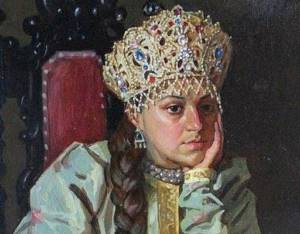
Maria Temryukovna - the second wife of Ivan the Terrible
The ruler of the Ottoman Empire liked her. Salimiye even gave birth to Shahzadeh. But the spy’s reports to Moscow were boring and uninformative. After the death of Hurrem, his elder sister Mihrimah became in charge of Sultan Selim's harem. Moon-faced quickly identified the spy.
Selimiye admitted that she was sent by Maria Kuchenei with the aim of placing Selimiye’s son on the throne of the Ottoman Empire, concluding peace with Muscovy. Mikhrimah's reaction was lightning fast. Valide kicked her out of the harem, and sent killers to Moscow to poison the Circassian woman, so that it would not be common practice to poke her nose into the Turkish harem.
Second wife: Maria Cherkesskaya
The Tsar in Rus' was not supposed to live without a wife. In 1560, the search for a new queen began. The choice fell on the young princess, Maria Temryukovna. The daughter of the Circassian prince Temryuk was 16 years old, and marriage with the Russian Tsar was hardly the limit of her dreams. But they became an “ideal couple”; the common interests of the spouses were torture and executions.
Al Capone's "moonshine distillery" found in America - it's over 100 years old
How much did Russia spend on gifts on Valentine's Day?
Slender brunette with long hair Laysan Utyasheva radically changed her image
Maria had incredible, bright and bewitching, fabulous beauty. Perhaps this is how she seemed compared to the rather faded-looking Slavic women. But be that as it may, the king adored his young wife, she turned him around as she wanted. Maria quickly learned Russian and realized the power she had.
If Anastasia invariably extinguished attacks of anger, suspicion and cruel aggression, to which Ivan Vasilyevich was prone, then Maria did the opposite. She kindled and intensely fed all the base qualities of her husband. Maria participated in torture and was always present at executions. Historians believe that she “selected victims” from their pair, indicating to the king those who should be arrested and executed.
Maria gave birth to a son named Vasily. The child died at 2 months. The marriage lasted seven years and was very difficult. According to contemporaries, after the death of the child, the couple lost interest in each other, but they continued to be united by common inclinations.
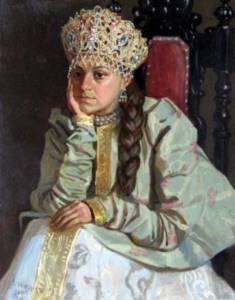
Maria fell ill and died suddenly. Her death is a big mystery. They buried her next to the first queen. Mary's sarcophagus was placed to the left of Anastasia's tomb.
Marfa Vasilievna Sobakina
According to the custom of the church, the king could marry three times, because the monarch already had male heirs. Therefore, the autocrat approached the choice of a bride carefully. At the first selection, 2 thousand girls were collected, at the second - 24, whom the king saw.
A dozen of them were presented naked before the bright eyes of the sovereign. The girls were examined by a doctor discharged from England for this purpose. It was not birth that won the competition, but beauty. 3 The Tsar's wife Marfa Sobakina came from a modest, poor family from near Kolomna.
Note: At the “beauty contest” a wife was also chosen for Tsarevich Ivan, the son of Ivan the Terrible - Evdokiya Saburov.
Immediately after the engagement, Martha began to “wither” and died two weeks after the wedding, on November 11, 1571.
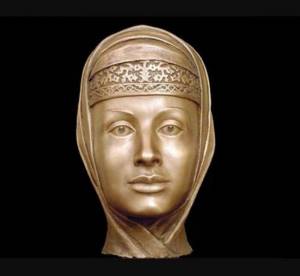
Marfa Sobakina remained the Tsar's wife for only 2 weeks
Third wife: Marfa Sobakina
Of course, everyone remembers the shot from the film “Ivan Vasilyevich Changes His Profession,” in which the impostor is interested in the name of the queen, and she replies: “I am Marfa Vasilievna.” Marfa Vasilievna Sobakina became the third queen. She went through a very serious “casting of brides,” which was initially conducted by the king himself, who decided not to trust anyone with the “preliminary selection” anymore.
An Australian couple took a huge python for a ride in their car.
Those who have been in contact with others while sick with COVID may be prosecuted
I take care of both my health and my money: 2 reasons why I avoid washed vegetables
More than 2,000 girls came to the Alexandrovskaya Sloboda for the bride's show. Seeing this crowd, Ivan the Terrible changed his mind and decided to carry out the process the old fashioned way, sending midwives to the women to begin with. He himself deigned to go out to the girls only when there were 24 of them. Grozny eliminated half of them immediately, but he liked the remaining 12. After much thought, Grozny decided that he liked Marfa more.
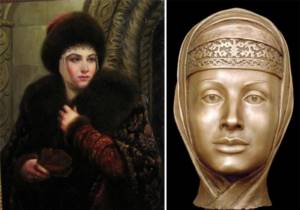
The dog was beautiful. The reconstruction of her face, carried out using Gerasimov’s method, eloquently testifies to this. But is beauty alone enough to find a place in the heart of such a person as Ivan IV? Unfortunately, Martha did not have time to find out this.
Her marriage lasted only a couple of weeks, after which the queen died suddenly. Grozny was sure of poisoning. Almost 20 people were arrested and executed on suspicion of conspiracy.
Anna Koltovskaya
Ivan the Terrible swore to the clergy that his third wife was not his true wife, since due to the bride’s illness “he did not allow her virginity.” The king was allowed to marry again. They did not hold a new viewing of brides.
The king simply made 4 his wife the “runner-up” of the previous beauty contest. Anna was the daughter of Alexei Ignatievich Goryainov-Koltovsky, from a not very noble family of Kolomna. Little is known about the woman.
It is believed that Anna’s father died in captivity, and the girl and her brother were raised at the court of Andrei Kurbsky. After the engagement, the bride's brother and uncle increased their social status. The wedding took place in Novgorod in the spring of 1572.
In the fall, the beauty fell out of favor with the king, and the monarch, without any special ceremony, exiled Anna to the Tikhvin Monastery, where she took monastic vows like the nun-queen Daria. As in the fairy tale about Cinderella, all the well-being of the family collapsed overnight, and Ivan the Terrible executed his brother. What was the reason for such disgrace is not completely known.
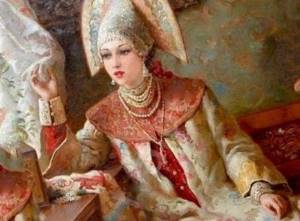
Anna Koltovskaya
Anna's family
The exact date of birth of Queen Anna is unknown. Anna Koltovskaya came from a poor family. Not a single relative of hers could be given dignity in the State Duma. Anna's father is Alexey Ignatievich Goryainov Koltovsky. There is controversial information that after the loss of her parents, Anna was in the care of Prince Andrei Kurbsky.
According to the description of the “Orthodox Encyclopedia”, the Koltovskys were service landowners. Anna's father and brother Gregory were in the second half of the 16th century. boyar children in Kolomna. It is known about my father that he died in captivity. And it is known about his brother that he was the guarantor of Prince I. F. Mstislavsky. In general, historical sources indicate an insignificant role of Anna's family at court, who occupied low positions.
Maria Dolgorukova
The report about this person is unreliable. The woman is mentioned by Jerome Horsey, the former ambassador of England at the court of Ivan Vasilyevich the Terrible. The diplomat reports that in 1573 the tsar “brought Maria Dolgorukova closer to himself,” since he could no longer get married, but the next day, “due to the loss of her virginity even earlier,” he ordered the woman to be imprisoned in a cage and drowned in the lake of the Alexander Sloboda.
Historians have questioned this story. There are no certificates of honor for Mary and the bride's relatives. And the Dolgorukov family is too noble for such an event not to become a documented scandal.
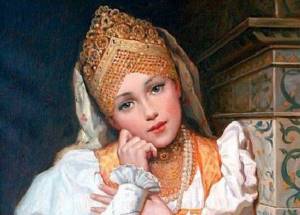
Maria Dolgorukova is not mentioned in all historical sources
Anna Grigorievna Vasilchikova
The woman, unlike the previous wife, was the real, albeit unmarried, wife of Ivan the Terrible. Anna was the daughter of the boyar and diplomat Grigory Vasilchikov “from the family of the Kashirsky boyars.”
Historians do not call Anna the queen, since there was no wedding, and the boyars and the Duma were not invited to the wedding. The social celebration, which took place at the end of 1574 or in January 1575, brought together 35 guests, most of whom were relatives of the bride. They were treated kindly from the royal treasury.
Less than a year had passed before Ivan the Terrible lost interest in his fifth wife and, following the example of Anna Koltovskaya, exiled her to the Intercession Monastery in Suzdal. The date of the woman’s death is known – January 1577.
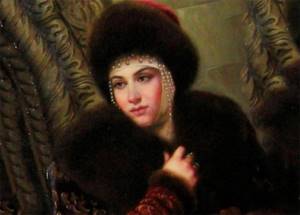
Anna Vasilchikova was exiled to a monastery when the Tsar lost interest in her
Anastasia Zakharyina-Yuryeva
The first wife of Ivan the Terrible. Their wedding took place when the young king was 16 years old. The bride herself was a boyar’s daughter from the Romanov family. Anastasia was the first and only wife of the Tsar, who influenced him only from a positive side. The girl herself was kind and sympathetic. The marriage produced six children, four of whom died in infancy.
Anastasia did not live to see her 30th birthday, fell ill and died. The causes of death were frequent childbirth, weakening of the body and poisoning. Today, many researchers are inclined to the latter version - traces of mercury were found in the remains of the queen.
Vasilisa Melentyeva
7 The king's wife was not quite a wife. Sources call her "zhenishche", which means "concubine". Ivan the Terrible became friends with her “by prayer alone,” that is, without any ritual. Vasilisa is often called the widow Melenteva. Her husband was allegedly killed by a guardsman.
The Tsar made the beautiful widow his de facto wife at the end of 1575. Disgrace followed no later than May 1577, since Vasilisa looked kindly at the “armsman Ivan Devyatilev, whom he executed.” Ivan the Terrible exiled the woman herself to a monastery, however, the place of her tonsure is unknown.
Note: Historians consider Vasilisa a fictional character, since she is not mentioned in official documents. However, the beautiful widow served as a source of inspiration for artists N. Nevrev, G. Sedov and writer A. Ostrovsky.
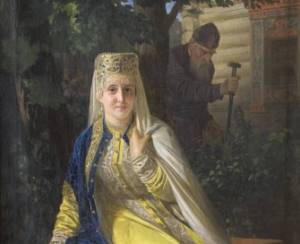
Vasilisa Melentyeva is considered a fictional character
In monasticism
It is not known exactly where and when Anna Alekseevna took monastic vows. According to one version, this happened 4.5-5 months after the wedding in 1572. According to another, 3 years later in 1575.
Most historians believe that she was exiled to the Vvedensky Monastery in Tikhvin, where she took the monastic name Daria in September 1572.
In 1586, Anna was mentioned as the abbess of the Monastery of the Resurrection of Christ in Goritsy. In 1608-1626. was the abbess of the Tikhvin Monastery of the Presentation of the Blessed Virgin Mary into the Temple. She was buried in the monastery.
During the last years of Ivan the Terrible’s life, the tsarina lived in Suzdal in the Pokrovsky Monastery, in which lived other prisoners of the tsar who had fallen out of favor and were exiled. Maria Fedorovna Nagaya and the second wife of Tsarevich Ivan Ivanovich, Feodosia Solovaya, were also there.
By the way, only Anna Alekseevna and Maria Fedorovna Nagaya, the last wife of Ivan the Terrible, survived the tsar. Anna outlived her husband by as much as 42 years.
